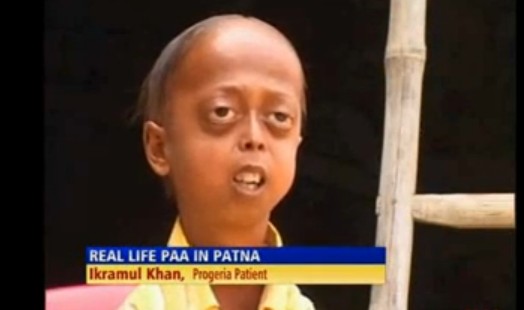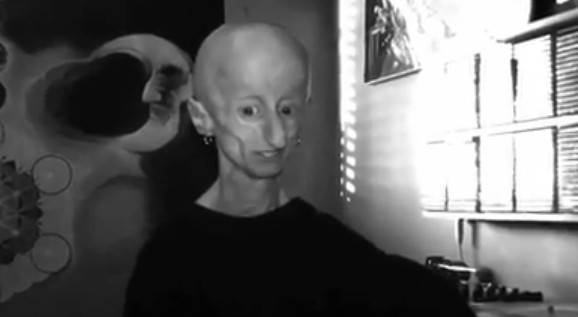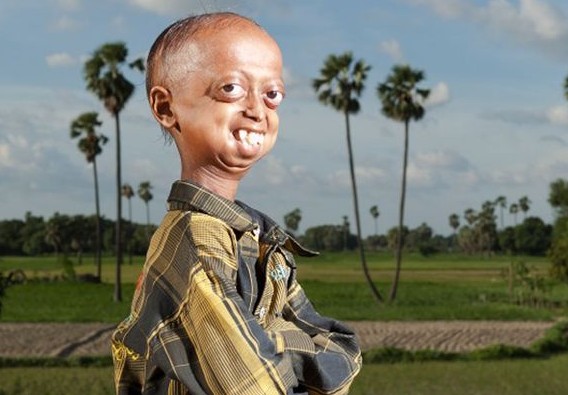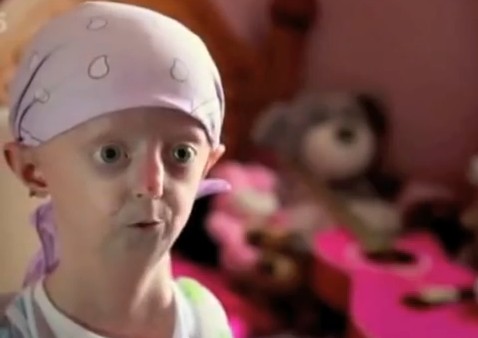Progeria, also known as HGPS (Hutchinson-Gilford Progeria Syndrome), is a very rare and fatal genetic condition. The name is derived from the Greek word ‘progeros’, which means to get age prematurely. Children who are born with this genetic defect start to grow old very fast. This means that a child may be a year old, and have the appearance of someone in their middle age. The term ‘progeria’ first came into existence in the year 1886 after an English doctor Jonathan Hutchison documented about the disease. Later, another English doctor Hastings Gilford elaborately described about this condition, in the course of his independent findings in 1897.
What are the signs of Progeria?
Children who have progeria have a cell nucleus that has an anomalous shape instead of the uniform round shape that is found in normal cells. When these children are born, they look healthy and normal and the signs of ageing begin to show when the child is about 10 to 24 months old. Some of the signs that a parent will notice include:
- Poor and abnormally slow growth
- The loss of both body fat and hair
- The child develops stiffness in the joints
- The child develops an ageing skin characteristic
- The child develops cardiovascular conditions (Atherosclerosis)
- The hips of the child dislocate as he or she tries to walk
- The child gets stroke
Children with progeria develop a similar look, even when they come from different ethnic backgrounds. Most of these children die at the age of 8 to 21, which makes the average age to be 13.
What are the causes of Progeria?
A high proportion of the children with progeria have a mutation of the gene that determines the coding of the protein, Lamin A, which is the one that holds the cell together. The defective protein causes the nucleus to be unstable and the unstable nucleus leads to rapid cell degeneration causing the rapid ageing. Progeria is usually a one time occurrence, with the siblings of these children not developing the condition. It is extremely rare that you find two children in one family having the same disease.
Statistics and Survivors
There are currently 80 cases of progeria that have been reported around the world and 2 are from the UK. It is said that the condition is so rare, that only 1 out of about 4 million children get it. Progeria does not have prevalence in any gender and affects both equally. Similarly, Progeria does not discriminate by race and appears across all ethnic groups. 31 countries in all, have reported cases of progeria.
Six children in one family in India were born with progeria and at this point of time, only one, Ali Hussain (13) is alive. South African hip-hop artiste, Leon Bontha , one of the oldest afflicted patients, died in 2011, at the age of 26.
Hayley Okines, an English girl who was diagnosed with progeria, is now 15 years old. She is an inspiration to many, and has even beaten the prediction of medical specialists who thought that she would not live for long. Adalia Rose Williams, at the age of 6, has become an Internet sensation with 6 million Facebook fans, after the videos of her dancing to ‘Gangnam Style’ and ‘Ice Ice Baby’ were posted online.
What are the similarities of Progeria and old age?
The most common similarity is that of developing progressive cardiac disease. Almost 98% of Progeria patients die of cardiac arrest. When you compare this to the figures of people who die of heart disease in their old age, you begin to see the similarity. Other conditions linked to normal old age, such as angina, enlarged heart, high blood pressure, stroke and heart failure are found in these children. Due to this similarity, experts say that research into ways of treating progeria will also bring about a way in which to slow down the process of normal ageing in people.
What is the diagnosis of Progeria?
The main way of diagnosing the condition is by looking for the signs and symptoms. These will include aging skin, stiff joints, hair loss, and most of the other symptoms listed above. The doctor will then confirm the type of progeria by doing a medical test. There is a Progeria Testing Program, developed by the Progeria Research Foundation that can be of great help.
Is Progeria passed on down the hereditary chain?
According to research, Progeria cannot be inherited. The gene that causes this condition is very rare, and this mutation happens purely by chance. Any child born into a family with a Progeria patient stands the same chances of developing the condition as another child born into a family without a history of the condition. The defective gene is only passed down to the next generation in 1% of the affected families.
Is there hope of a treatment being found?
There are medications that are used to treat cancer that seem to be slowing the premature ageing down. Researchers say that the Farnesyltransferase inhibitors (FTIs) might be the key to reversing the abnormal structure of the nucleus which is the one that causes Progeria. The drugs have been tried on mice that have similar symptoms to Progeria and there seems to be some success. Out of 13 mice that were under observation, only one died in a study that lasted 5 months. The results of this study have given researchers confidence to start clinical trials in children with Progeria. The clinical trials started in September, 2012, and have showed that children given this treatment had improved bonbe structure, gained weight, and had better blood circulation systems.
Much is to be done to ensure that these children get a chance of living a normal life. Progeria is a regrettable condition, but one which touches many peoples hearts. Unlike other genetic abnormalities, which allow children top live long, despite having birth defects, victims of progeria are destined to live a short life right from birth. This treatment has given hope to a lot of parents and children.
Movies based on Progeria
Paa, a Bollywood movie, released in 2009, had the megastar Amitabh Bachchan playing the role of the progeria-affected child. Movies like Renaissance, Jack and The Hunger also had references to this disease.
Progeria Pictures







